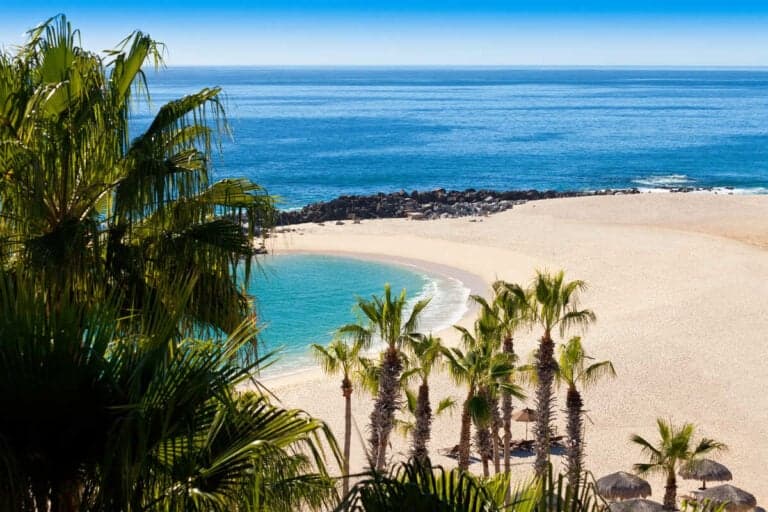Sargassum is making a comeback sooner than expected this year, and a powerful one at that, threatening to ruin vacation plans for thousands of travelers.
It may not be life-threatening, but for the average beachgoer, it does something even worse:
The proliferation of the foul-smelling seaweed tarnishes the typically-pristine beaches, accumulating in large deposits on the white sands like stains, and at times, they spread so disruptively beaches have to be closed so more intense cleaning can be carried out.
Still, there are four incredible beach hotspots where sargassum is unlikely to be a major concern for you if it will be a concern at all:
Los Cabos

A laid-back leisure destination in the Mexican Pacific, the twin cities of Cabo San Lucas and San Jose del Cabo, which together form the upscale ‘Los Cabos‘, are best known for their luxury hotels, world-renowned wellness scene and abundant nature.
It is where several iconic natural wonders are located, including marine preserve Cabo Pulmo and the ‘Arco’ in Cabo San Lucas, an arched rock formation rising out of the azure waters, and it’s been challenging Cancun for the title of Mexico’s number one resort spot for a while now.

The fact that Cabo does not see any seaweed may help it overtake the Quintana Roo giant in the coming months, as the Pacific is colder than the tropical Caribbean, which is part of the Atlantic, where sargassum originates.
In short, the worrying phenomenon is not observed in Cabo, and the beaches remain an unspoiled shade of gold year-round.
Mazatlan
A fast-growing beach destination in the state of Sinaloa, Mazatlan also straddles the Pacific coast, meaning sargassum should be the last of your concerns when vacationing here.

Additionally, the beaches are remarkably clean, as ‘Maz’ is nowhere near as popular as jam-packed Cancun.
If you’re looking for charming coastal zones to bask in that Mexican sun, the Golden Zone and Cerritos should be at the top of your bucket list.
Teeming with sunbathers and swimmers this time of year, they offer foreign visitors a lively social scene, as well as a high concentration of beachfront restaurants, with the best seafood you’ll ever have, and relatively affordable condo rentals.

Besides being sargassum-free, Mazatlan’s true charm lies in its mix of Modern and Old Worlds: the historic center is dominated by colorful colonial-era buildings dating back centuries, yet the beachfront is lined by high-rises and Mexico’s usual palm-lined malecon.
Puerto Vallarta
Our third pick is, surprise, another Pacific gem: Puerto Vallarta has zero sargassum this summer.
On the other hand, it is teeming with life and activity, with trendy bars that overflow with young, sociable tourists, and an upscale, well-frequented boardwalk leading to one of Mexico’s most scenic beaches.

The heart of town is the Bohemian Zona Romantica, where most of the entertainment venues and winding cobbled streets are, as well as the beautiful traditional architectural and landmark buildings, such as the magnificent Church of Our Lady of Guadalupe.
Beaches in PV (as it is known in its short term) may be protected against the invading seaweed, but that’s not to say they are perfectly serene.
Beach conditions can vary day to day, where one day might be perfect and the next may have undercurrents ready to wash you away. Travelers are being urged to be more cautious when swimming in the area, as there may be strong undercurrents.

Regrettably, there have been some casualties lately, especially tourists who are not fully aware of the risks, or who choose to ignore the black and red flags perched on the sands.
Learn more about the risks, and how to improve your safety on local PV beaches here.
Isla Mujeres
We know what you’re thinking.
Isla Mujeres is a Caribbean destination, so it can’t possibly be free of sargassum at the peak of seaweed season when, well, the Caribbean is the most heavily affected sea… right?

We’re glad to report that’s a common misconception, as despite the Caribbean’s long-standing issue with the smelly algae, Isla Mujeres in particular is largely cordoned off due to its strategic geographical location.
Much of the sargassum that will batter the mainland coast will generally miss Mujeres altogether, as it the ocean currents that pass the island do not carry the seaweed, the small amount that does make landfall is a lot less noticeable.
Additionally, Isla Mujeres is a tiny island, only 4.3 miles long and 2,130 feet wide, meaning beaches do not extend for miles on end as far as the eyes can see, and there’s not a lot of cleaning to do every morning following whatever moderate overnight arrival of sargassum.
Credit: Source link

